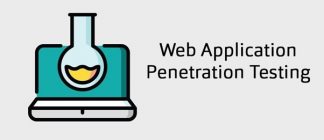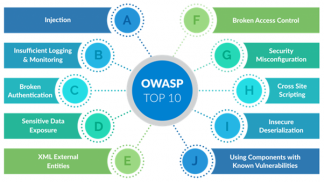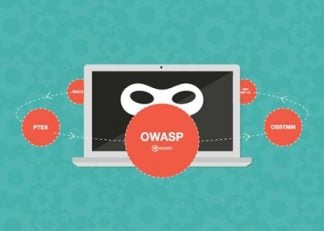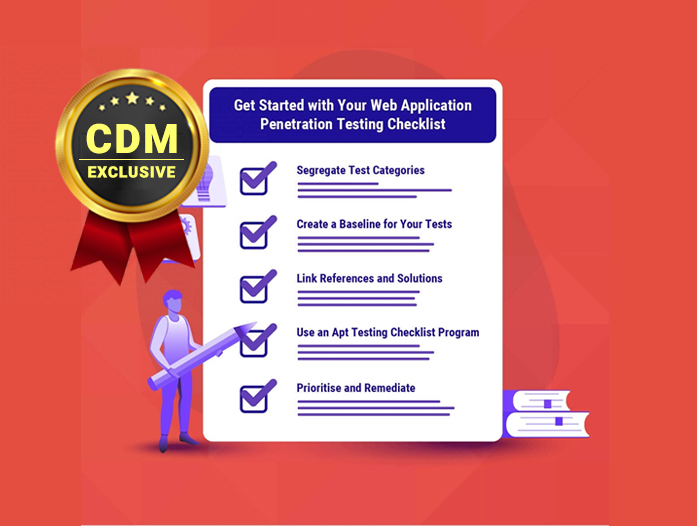We’ve compiled this article to explain the top 10 web application security risks according to OWASP and how you can use them as a guide and light during penetration testing.
By Ankit Pahuja, Head of Marketing and Evangelist at Astra Security
Image source: Appknox.com
We live in a world where the Internet has forever changed our daily lives. The physical presence of both parties in the same room is no longer required when working and interacting with each other. The number of people using the Internet is growing rapidly and currently has access to approximately 3 billion people. This has resulted in the exponential growth of web applications in recent years. Web applications are convenient, but they also have weaknesses. When it comes to web application security, organizations penetration testing To identify potential vulnerabilities and weaknesses in your application. We’ve compiled this article to explain the top 10 web application security risks according to OWASP and how you can use them as a guide and light during penetration testing. Start.
What is penetration testing?
Penetration testing, especially in the domain of web applications, is the process of testing vulnerabilities by simulating attacks for vulnerabilities. Penetration testers use a variety of methods to exploit vulnerabilities to gain access to sensitive data or systems. The main goal of penetration testing is to identify, report, and fix potential security vulnerabilities in your organization’s web applications as quickly as possible.
Why should you perform penetration testing of your web applications?

Image source: foregenix.com
Web application pen testing is done for a number of reasons. The most important are:
- To ensure that online applications are more secure and have few or no vulnerabilities
- to prevent unauthorized access
- Compliance with external regulations, policies and standards
- To meet internal security requirements
- To validate the effectiveness of security controls
- To troubleshoot previously discovered issues online penetration testing
- To stay competitive with other top companies
What are the OWASP Top 10?

Image source: cybervaultsec.com
OWASP stands for Open Web Application Security Project. The OWASP Foundation is a global, non-profit organization dedicated to improving the security of web applications and related technologies. OWASP We publish an annual list of top 10 web application vulnerabilities. This list was originally published in 2007 and has been updated since then. It covers everything from common coding to cyberattacks. This isn’t the only threat, but it’s the most common threat web developers must address before releasing their apps to production for use by their customers, clients, and employees.
OWASP Top 10 Web Application Security Risks in 2022
- Broken Access Control – Attackers can gain access to resources or data they should not have access to if common security measures such as permissions and access controls are not properly implemented.
- Encryption Failed – An encryption failure is when a web application’s underlying encryption algorithm or protocol is compromised and can be exploited.
- Injection and Cross-Site Scripting – Injection occurs when an attacker can inject malicious code into an input field on a web page, such as a search bar or comment box. Cross-Site Scripting is when an attacker injects malicious code into a web page while or before another user is viewing it.
- Unsafe design – Web applications designed in an insecure way leave room for attackers to exploit them. This often happens because web application developers are not familiar with secure coding practices.
- Incorrect security configuration – Misconfigured security settings are so prevalent that attackers can easily exploit them.
- Vulnerable and outdated components – A vulnerable and deprecated component could be involved if an attacker could exploit a known vulnerability in an application or underlying platform.
- Identification and authentication failure – This is when an attacker can impersonate another user or gain access to a restricted section of an application without proper authentication.
- Software and data integrity errors – This occurs when an attacker can access sensitive information within the application, such as user credentials or credit card numbers.
- Security logging and monitoring failures – Security logging and monitoring failures occur when an attacker disables or bypasses logging mechanisms, making it difficult to track activity within an application.
- Server side request forgery – This happens when an attacker can inject illegal requests on the server side, such as forging login credentials.
This is a common mistake developers make when creating websites, and if exploited, it can have serious consequences for your business, including data theft or financial loss!
What is OWASP Penetration Testing?

Image source: kirkpatrickprice.com
OWASP Penetration Testing A pen test to eradicate the vulnerabilities mentioned in the OWASP Top 10 list. This is a good starting point, but penetration testing should not be limited to this.
OWASP Penetration Testing Checklist
With the OWASP Top 10 Web App Vulnerabilities in mind, we’ve compiled a checklist to assist you in your penetration testing process.
- Review the architecture and design of your application
- Identify and attempt to utilize all input fields, including hidden ones
- Tampering with data entered into the application
- Find vulnerabilities using a variety of automated tools
- Network scans for exposed systems and services
- Attack Authentication Mechanism – Log in as another user using known credentials or use brute force techniques.
- Attempts to access restricted portions of the web application that only authorized individuals should be able to access.
- Intercepting and modifying communication between client-side and server-side
- Exploit known vulnerabilities in web application platforms or underlying frameworks.
After completing penetration testing, document the results in a concise report and begin patching your web application immediately.
conclusion
Penetration testing is a very important step in web application security and should not be overlooked. The OWASP Top 10 list is a great starting point, but it shouldn’t be the end of your penetration testing journey. For penetration testing to be effective, it requires an experienced security team capable of performing these types of audits and providing actionable results in a timely manner.
About the author
 Ankit Pahuja is Marketing Director and Evangelist at Astra Security. After becoming an adult (literally at the age of 20), he started looking for his vulnerabilities in websites and network infrastructure. He can make “marketing engineering” a reality as he begins his professional career as a software engineer at one of the unicorns. After more than two years of active work in the cybersecurity field, he became a complete T-shaped marketing expert. Ankit is an avid speaker in the field of security and has lectured at leading companies, early-stage startups and online events.
Ankit Pahuja is Marketing Director and Evangelist at Astra Security. After becoming an adult (literally at the age of 20), he started looking for his vulnerabilities in websites and network infrastructure. He can make “marketing engineering” a reality as he begins his professional career as a software engineer at one of the unicorns. After more than two years of active work in the cybersecurity field, he became a complete T-shaped marketing expert. Ankit is an avid speaker in the field of security and has lectured at leading companies, early-stage startups and online events.
Ankit can be accessed online at: e-mail, LinkedIn and on his company website http://www.getastra.com/
Fair Use Notice: “Fair use” laws allow other authors to make limited use of the original author’s work without permission. Under 17 US Code § 107, “It is not copyright infringement to use copyrighted material for purposes such as criticism, commentary, news reporting, education (including multiple copies for classroom use), scholarship, or research.” As a matter of policy, fair use is based on the belief that the public is free to use portions of copyrighted material for the purposes of comment and criticism. Fair use privileges are perhaps the most important restrictions on the exclusive rights of copyright owners. Cyber Defense Media Group is a news reporting company that reports cyber news, events, information and more free of charge on its website Cyber Defense Magazine. All images and reporting are conducted exclusively in accordance with the fair use of US copyright laws.
